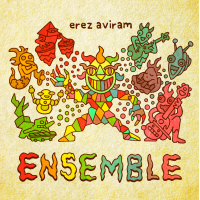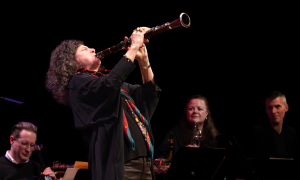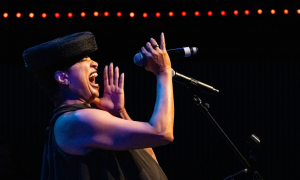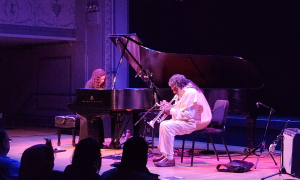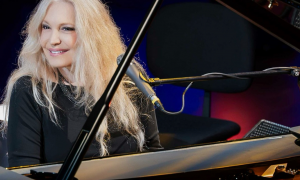Home » Jazz Articles » Live Review » On The Road With The Asian Jazz All-Stars Power Quartet
On The Road With The Asian Jazz All-Stars Power Quartet
The next stop was Ronnie Scott's Jazz Club in London. The mission—try out the KeyB organ. A friend of Monteiro, Italian organist Alberto Marisco was playing there in Norwegian guitarist Frode Kjekstad's Italian Job Trio Frode Kjekstad's Italian Job Trio and had told Monteiro to swing by during the afternoon to try it out for size. The appointment had to be cancelled, but Monteiro decided to go along to the late-night gig to at least hear the KeyB in action. There were a few familiar faces from the London Jazz Festival soaking up the informal atmosphere and although the club was less than packed the crowd was in good tune.
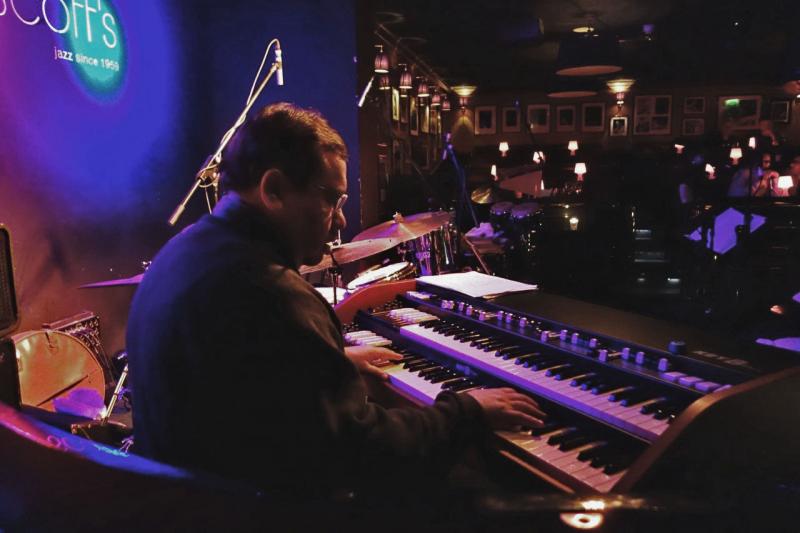
Marisco—equally adept at both jazz and blues organ styles—came to Monteiro's attention a decade before. "He came to Singapore for a gig and I helped him find an organ," said Monteiro. "He's a really fine player." Joey DeFrancesco, one of the modern greats of the organ, is also a big fan of Marisco and it was easy to see why during the next hour or so. As luck would have it, Marisco had to leave shortly into the second set to catch a night bus to Scotland, so Monteiro didn't have to think twice when Ronnie Scott's evening host, saxophonist Alex Garnett, invited him to the stage to fill the organ chair.
Monteiro played beautifully for thirty minutes before relinquishing the reins as an open-stage jam session unfolded. Afterwards, his smile said it all and he was unreserved in his praise for the KeyB: "I love the Nord Organ but the Key B is the best thing I've tried so far, save the original Tonewheel B3," he said. "To me, the Key B feels and sounds better than anything out there at this time except for the very few original Hammond Tonewheel organs still in existence. In the war of the clones—including Hammond's own clone wheel—I think Key B is the current front-runner."
It had been a fascinating and fun day, testing out the latest in piano and keyboard technology. As technology changes so too do the sounds of modern instruments, and it follows, the sound of jazz.
Pink Pianos/Jazz Purity
London came to an end all too soon, though just before boarding the Eurostar at St. Pancras bound for Paris there was some impromptu entertainment when Monteiro stumbled across a slightly beat-up pink piano in the terminal promenade. Though more used to Yamahas and Steinways, Monteiro took the role of bar-room honky-tonk pianist with natural flair, unrolling blues, jazz and classical lines on this object trouve, stopping passersby and turning heads. Every train station in the world should have a beat-up old piano with a sign hanging from it saying "Play Me."

Forty meters under the English Channel, traveling at around 300 kilometers per hour, the AJASPQ was in relaxed mood. Complementary reading material included a copy of Metropolitan, one of whose front page headlines was: "The Future Sound of Jazz: Purists Against Heretics at the London Jazz Festival." The question as to what jazz is—and what it's not—continues to arouse debate, though for the members of the AJASPQ the consensus was very much on the side of saxophonist Jan Garbarek, who was quoted in the article by John Lewis as saying: "The idea of purity in jazz is nonsense. All the music we make is feedback."
This year's London Jazz Festival was extremely eclectic, covering the full spectrum of jazz genres, as well flamenco, Brazilian and African music and avant-pop. In a festival the size of London's such anomalies barely create a ripple amongst the purists, as the feast of jazz is bountiful, but in smaller jazz festivals it's easier to scrutinize and criticize programming which leans precariously away from jazz in balance. Monteiro has always respected the tradition and the roots of jazz whilst welcoming innovation, but his opinion as to what constitutes a jazz festival—and what doesn't—was pretty clear-cut: "I think a jazz festival should have at least 60% jazz; if it's less than half then it should just call itself a music festival."
France, Workshop and Gig
Less than an hour later, the AJASPQ disembarked in Paris. The visit was short, just an overnight stay before heading on to Segré the following morning. Nevertheless, there was time enough for the team to enjoy a sensational bistro meal with a couple of bottles of red wine. Pao and I then headed to Ducs Des Lombards to catch drummer Billy Hart's quartet with saxophonist Mark Turner, pianist Ethan Iverson and bassist Ben Street. Now 71, Hart is a prime example of a jazz musician who has moved with the times, as the quartet's All Our Reasons (ECM, 2012) elegantly demonstrates.
Segré, a picturesque town in the Maine-et-Loire department of western France, punches above its weight. In 2010, this town with a population of just 7,000 launched the Saveurs Jazz Festival. The honor of playing the very first concert fell to Monteiro on a bill that also included the trio of piano legend Ahmad Jamal.
In its first three editions—held each year in August—the Saveurs Jazz Festival has also drawn musicians of the caliber of accordionist Richard Galliano, trumpeter Nicolas Folmer, saxophonists Archie Shepp, Chris Potter, Dave Liebman and Rosario Giuliani, bassist Richard Bona, guitarist Bireli Lagrene, violinist Didier Lockwood and drummers Daniel Humair and Ari Hoenig. It's clearly a jazz festival of some ambition.
The AJASPQ was invited to Segré as part of the year-round Segré Cultural Festival—a festival that celebrates the arts in all its forms—and the reception given and the hospitality accorded the AJASPQ and the team was exceptional.
First up was a workshop attended by 20 children aged 12-15 from the George Girande orchestra. The workshop provided the opportunity for the AJASPQ to try out a Monteiro composition, "Seul a Paris," for the first time and limber up for the following evening's performance. A question-and-answer session brought some intelligent questions from the young students about skills development, improvisation and acquiring a sound. "The bottom line is practice," Monteiro advised. As for improvisation, Tolentino said: "Listening is the key. Listen to lots of music."
For the drummers among the students Hong made this observation: "The cymbals reflect your sound, your personality." The students showed great interest in Pao's pedal board and the range of sounds it produced, gathering around the guitarist with obvious enthusiasm as he patiently demonstrated the full range of tricks in his box. "When I started out it was just fuzz box and wah-wah," said the 53-year old, grinning.

The hall of Segre's Cultural Center was almost full when the AJASPQ came on stage the next evening to warm applause, a reception that set the tone for the evening. The musicians gave their all in the best performance of the tour and the audience responded generously, the two entities feeding off each other's energy. The concert began with a delightful rendition of "Autumn Leaves," which evolved from Monteiro's classically-inspired intro to a more dynamic group statement. Pao's "Make it So"— inspired by Star Trek: The Next Generation—was a heady bebop-flavored workout. The collective energy levels were high, prompting Monteiro to say afterwards: "Normally we play that at Warp three but tonight we played it at Warp nine."
"Jingly Nona" saw a terrific three-way dialogue between pianist, guitarist and saxophonist. "African Skies" closed the set with fireworks and the inevitable and much deserved encore saw the band dust down "Carrot Cake"—another Peter Bernstein composition—for the first time since the previous year's tour. With the crowd clapping encouragement the musicians in turn gave energized solos over the infectious 1960s Blue Note-era groove. The band took its bows to a standing ovation after a memorable two-hour performance. On the way out, I asked some of the children from the George Gironde school who had attended the afternoon's workshop what they thought of the concert: "Amazing," said one; "Incredible," another. Bowmore malt whiskey replaced Guinness as the celebratory liquid, generously poured by our wonderfully convivial French hosts until late into the night.
Wrap-up
The final gig on the tour was in Hong Kong four days later. That gave all the musicians the chance to head to their separate homes to recharge the batteries. The AJASPQ and I parted company at Singapore airport. I couldn't make the Hong Kong concert—a late addition to the tour schedule—as I was covering the Penang Island Jazz Festival in Malaysia at the same time. I would have loved to have been there to cross the finishing line with my traveling companions of the last two weeks but it wasn't to be. Nevertheless, I am privileged to have been part of the AJASPQ's first foray into Europe and the energy and excitement of those half dozen gigs and the fun along the way will linger long in the memory.
Some of the best, most original jazz concerts I have seen since 2006, when I began writing for All About Jazz, have been by Asian bands. Thailand's Pomelo Town, Taiwan's Sizhukong, China's SIU2, Indonesia's simakDialog, Korea's Park & Miyeong duo, Japan's Pe'z—each radically different—have all impressed. To this list I must add the Asian Jazz All-Stars Power Quartet, whose combination of lyricism, grooving rhythms and thundering fusion places it among the very best of today's jazz fusion bands.
The positive reception received by Monterio, Pao, Tolentino and Hong in both Asia and in Europe confirmed the universal appeal of the band's work. For Monteiro, the tour was a success on more than one level: "This tour was great because we got to strut our stuff in front of audiences which don't come to Asia and so would not be able to see us perform." The reception of the AJASPQ, especially in Europe, was of particular satisfaction to Monteiro: "The warmth of the audiences has inspired me to keep on keepin' on," he said.
With plans to record both live and in the studio, the AJASPQ is here to stay. Hopefully, European and American concert and festival promoters will recognize what the likes of Michael Brecker, McCoy Tyner and Chick Corea learned some time ago—these Asian guys can play their butts off.
Photo Credits
Pages 3 (top), 5 (top): Ian Patterson All Other Photos: Varian Monteiro
Tags
PREVIOUS / NEXT
Support All About Jazz
 All About Jazz has been a pillar of jazz since 1995, championing it as an art form and, more importantly, supporting the musicians who make it. Our enduring commitment has made "AAJ" one of the most culturally important websites of its kind, read by hundreds of thousands of fans, musicians and industry figures every month.
All About Jazz has been a pillar of jazz since 1995, championing it as an art form and, more importantly, supporting the musicians who make it. Our enduring commitment has made "AAJ" one of the most culturally important websites of its kind, read by hundreds of thousands of fans, musicians and industry figures every month.













